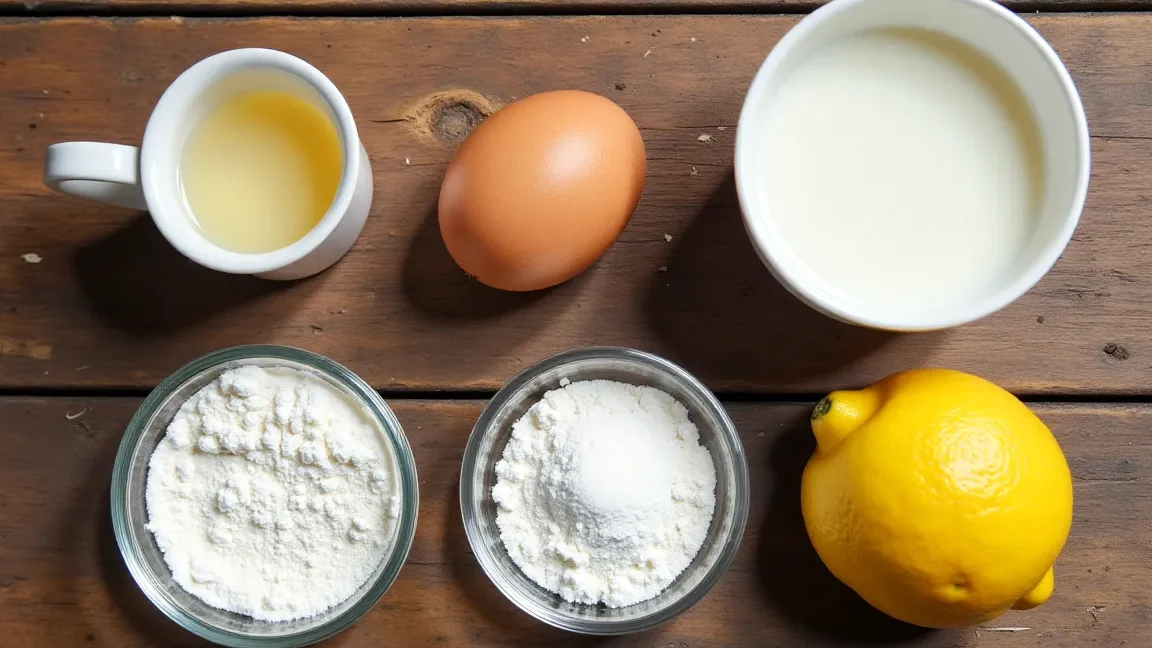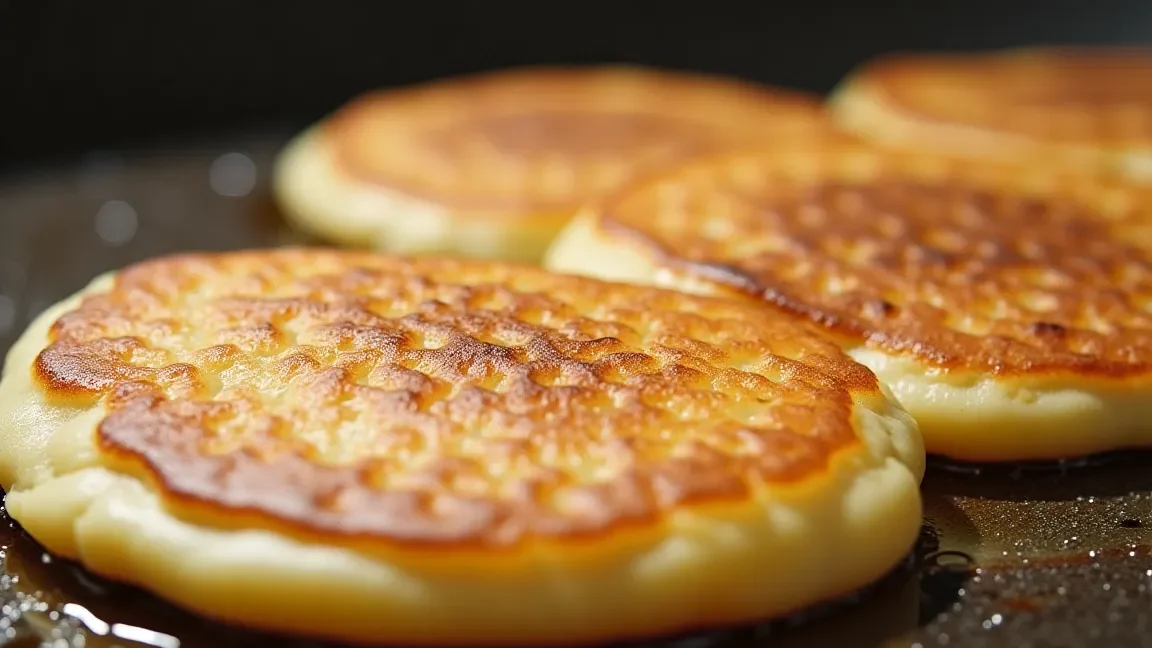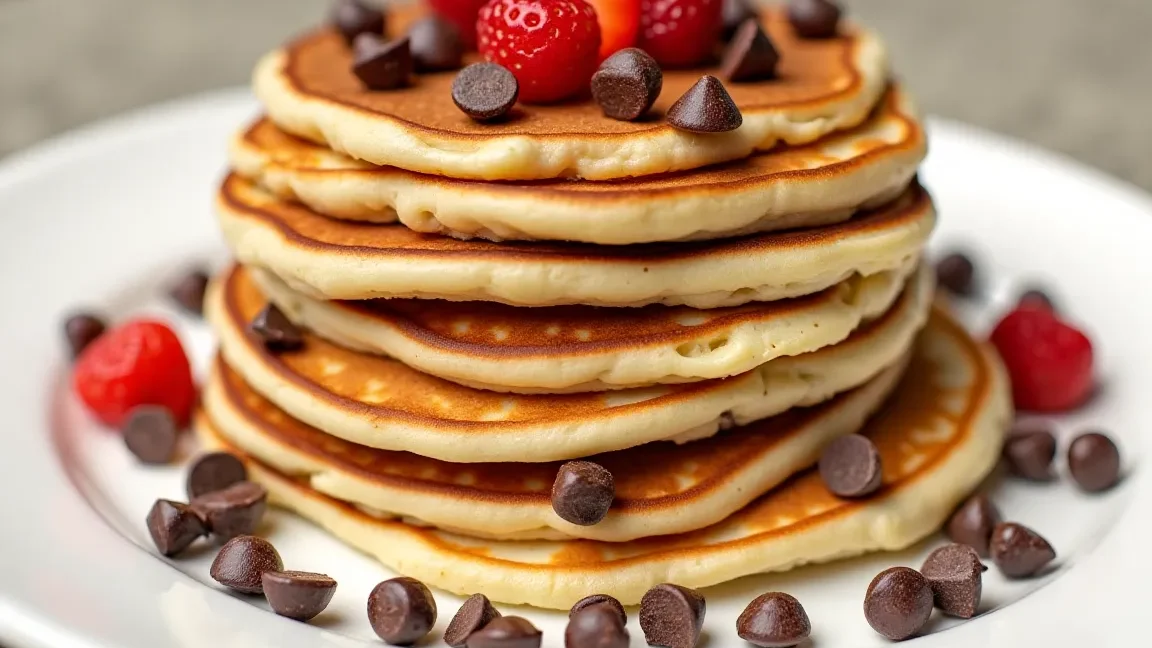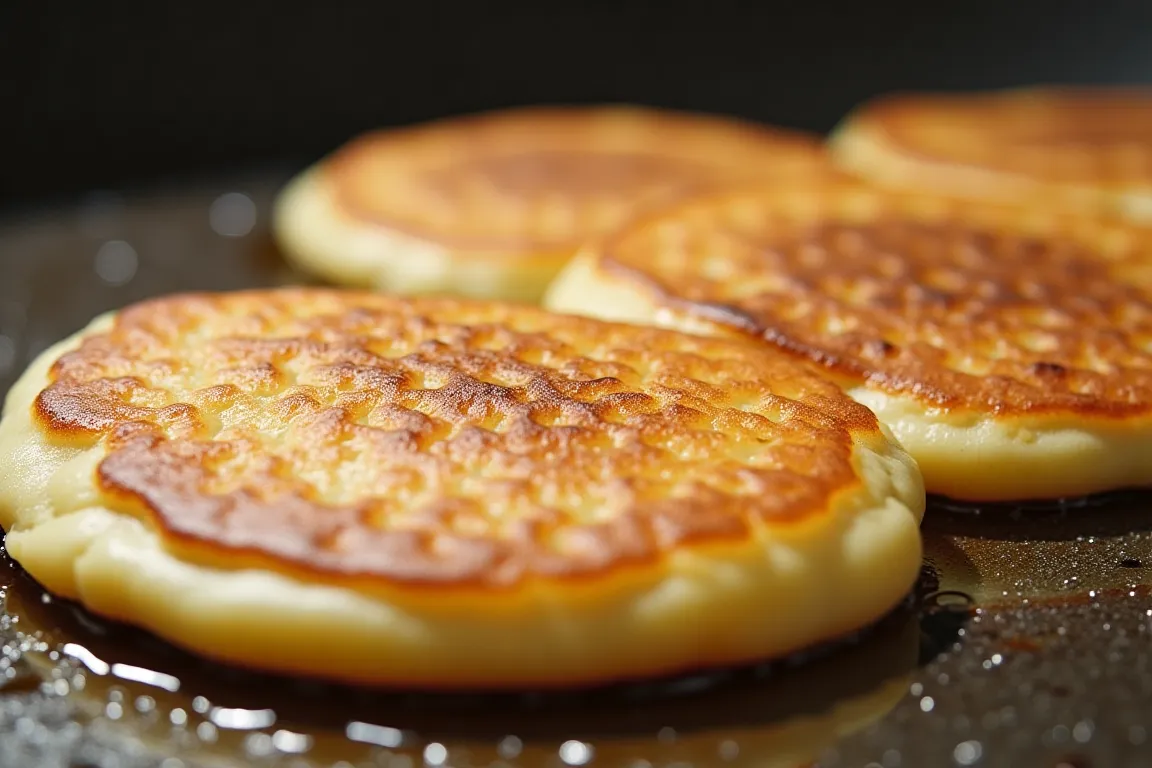Pancakes are a favourite breakfast for their soft, fluffy texture and comforting taste. While most recipes call for baking powder as a leavening agent, there are times when you might not have it on hand or prefer not to use it. Luckily, you can still whip up a delicious batch of pancakes with ingredients you likely already have in your kitchen. This article will walk you through a pancake recipe made with baking soda. It will also show different ways to get similar fluffy results.
The recipe isn’t just easy to make; it’s adaptable and can be used for any occasion. If you want to stay clear of additional ingredients or explore new cooking methods, the pancakes will be just as delicious as their classic counterparts. Let’s look at the ingredients and step-by-step procedure to prepare these pancakes quickly!
Table of Contents
Ingredients for an Easy Pancake Recipe Without Baking Powder

The key to creating pancakes that do not require baking powder is to use alternatives that effectively reproduce its leavening properties and give similar results. For instance, this recipe relies on simple, readily available components to ensure your pancakes turn light and fluffy and remain utterly delicious. Moreover, these alternatives are practical and accessible, making the recipe versatile and convenient.
Core ingredients for a fluffy texture in pancakes without baking powder
Here’s what you’ll need to make your pancakes without baking powder:
- 1 cup of all-purpose flour – The base ingredient for most pancake recipes. You can also use whole wheat flour to give it a healthier alternative.
- One cup of milk – Use whole milk for a richer flavour, or substitute it with plant-based options like almond or oat milk.
- 1 large egg – Provides structure and helps bind the ingredients.
- Two tablespoons of sugar – Adds a touch of sweetness.
- 1/4 teaspoon of salt – Enhances the overall flavour of the pancakes.
- Two tablespoons of melted butter or oil – Keeps the pancakes moist and prevents them from sticking to the Pan.
Substitutes for baking powder explained in this simple pancake recipe
In place of baking powder, this recipe instead relies on a combination of acidic and alkaline ingredients to effectively create a similar leavening reaction:
- 1/2 teaspoon of baking soda – Works as the alkaline component.
- One tablespoon of lemon juice or vinegar – Provides the acidity needed to activate the baking soda. Yoghurt or buttermilk can also be used as substitutes for this purpose.
For more details on creating your own leavening agent, check out How to Make Your Own Baking Powder.
Tips for choosing the right ingredients to make the best pancakes
- Flour: Ensure your flour is fresh and sifted to prevent lumps in your batter.
- Milk and Vinegar Combination: Mixing milk with one teaspoon of lemon juice or vinegar can mimic the effect if you do not have buttermilk. Let the mixture rest for 5 minutes, allowing it to make a curd before you use it.
- Butter: Use unsalted butter to control the saltiness of your pancakes.
If you’re considering using cornstarch instead, learn more in Can I Use Cornstarch Instead of Baking Powder?.
Now that you’ve gathered all the ingredients, it’s time to move on to the preparation process!
Step-by-Step Preparation for an Easy Pancake Recipe Without Baking Powder

Creating pancakes without baking powder is straightforward when you follow these detailed instructions. Therefore, the key lies in carefully balancing ingredients and proper mixing techniques to ensure fluffiness and a perfect texture.
Mixing wet and dry ingredients in this pancake recipe without baking powder
- Prepare the Wet Ingredients: Whisk the egg in a medium-sized mixing bowl until it’s light and fluffy.
- In a medium-sized mixing bowl, whisk the egg until it’s light and fluffy.
- Add the milk and melted butter (or oil) to the bowl. If you’re using the milk and vinegar combination, ensure the mixture has curdled before adding it.
- Stir in the vinegar or lemon juice (if not already mixed with milk) to create the acidic base needed for leavening.
- Mix the milk and butter that has been melted (or oil) into the bowl. If you’re using the milk and vinegar combination, ensure the mixture has curdled before adding it.
- Stir in the vinegar or lemon juice (if not already mixed with milk) to create the acidic base needed for leavening.
- Combine the Dry Ingredients: In a separate bowl, sift together the flour, sugar, salt, and baking soda.
- Sifting removes lumps and aerates the flour, contributing to fluffier pancakes.
- Mix Dry and Wet Mixtures. Then, slowly pour the wet ingredients over the dry ingredients.
- Make use of a spatula or whisk to gently fold the batter. Avoid mixing too much because this could make the pancakes brittle. Little lumps of batter are perfectly acceptable.
Proper technique for achieving fluffiness without baking powder in pancakes
- Let the batter rest for 5-10 minutes. This gives time for the baking soda to react with the acidic components, creating air bubbles that will help the pancakes rise when cooked.
- Ensure the batter is of a pourable consistency. If it’s too thick, add a tablespoon of milk at a time to loosen it slightly.
Cooking Tips for Golden-Brown Pancakes

- Preheat the Pan:
- Prepare the Pan by heating it with a non-stick skillet, griddle, or spoon at a moderate temperature. Then, lightly grease it with butter or oil to prevent sticking. Additionally, a well-preheated pan ensures even cooking and produces a beautiful golden crust.
- Pour the Batter:
- onto the skillet. Scoop approximately 1/4 cup batter for each pancake. Pour it into the skillet. Use the back of a spoon to spread the batter gently into a circle if needed.
- Cook Until Bubbles Appear:
- Let the pancakes cook undisturbed until you see bubbles forming on the surface and until the edges appear smooth and rounded (approximately 2 to 3 minutes).
- Flip the Pancakes:
- Using a spatula, carefully flip each pancake and cook for 1–2 minutes until the bottom is golden brown and cooked.
- Serve Immediately:
- Stack the pancakes on a plate and keep them warm by covering them with foil while cooking the remaining batter.
Troubleshooting Pancakes
- Flat Pancakes: If your pancakes don’t puff up, the batter may have been overmixed or the skillet too hot.
- Burnt Edges: Lower the heat slightly and ensure even greasing of the Pan.
Tips for Variations and Additions in Your Easy Pancake Recipe Without Baking Powder
After learning the fundamental pancake recipe with baking soda, it’s time to think of something new. Whether you’re looking for something sweet, savoury, or unique, These variations and tricks can elevate your pancakes to a new level.
Sweet Additions to Enhance Flavor
- Fruits:
- Add fresh fruits like blueberries, banana slices, or diced apples directly to the batter for a fruity twist.
- For caramelized sweetness, sprinkle sugar over the fruit before flipping the pancakes.
- Chocolate Lovers’ Delight:
- Mix chocolate chips or cocoa powder into the batter for a decadent, indulgent treat.
- Pair chocolate pancakes with whipped cream or a drizzle of chocolate syrup
- Spices and Extracts:
- Add a pinch of cinnamon, nutmeg, or vanilla extract to the batter to enhance the aroma and taste.
- Toppings:
- Serve your pancakes with classic toppings like maple syrup, honey, or powdered sugar.
- Try unique combinations such as Greek yoghurt, fresh berries, and a drizzle of honey for a healthier option.

Savory Pancake Variations
- Cheese and Herb Pancakes:
- Mix shredded cheese (like cheddar or mozzarella) and chopped herbs (such as chives or parsley) into the batter for a savoury twist.
- Vegetable Pancakes:
- Add grated vegetables like zucchini, carrots, or spinach to the batter season with a pinch of garlic powder or paprika.
- Protein Boost:
- Incorporate cooked and crumbled bacon, diced ham, or smoked salmon into the batter.
- Serve savoury pancakes with sour cream or avocado slices.
Customizing Pancakes for Dietary Needs
- Gluten-Free Pancakes:
- Replace all-purpose flour with a gluten-free blend or almond flour.
- Ensure all other ingredients are certified gluten-free.
- Vegan Pancakes:
- Substitute the egg with a flaxseed or chia seed mixture (1 tablespoon seeds + 3 tablespoons water, left to gel for 5 minutes).
- Use oil and milk made from plant sources instead of butter.
- Low-Sugar Pancakes:
- Reduce or eliminate added sugar and rely on natural sweetness from fruits or toppings.
Storing and Reheating Pancakes
- Storing Leftovers:
- Allow the pancakes to cool completely before storing them in an airtight container.
- Please keep it in the refrigerator for up to three days or store it in the freezer for up to 3 months.
- Reheating Tips:
- Warm pancakes in a toaster, skillet, or microwave for a quick breakfast.
- The ability to experiment with different variations makes your pancakes interesting and lets you adapt to different tastes and occasions. Whether it’s a special breakfast with your loved ones or an individual treat, the additions to your breakfast menu will never displease.
Frequently Asked Questions (FAQ):
Here are some common questions about making pancakes without baking powder and detailed answers to help you perfect your recipe.
How to Make Your Baking Powder
This article guides readers on creating homemade baking powder, which could be helpful for those who want a quick DIY solution while making pancakes.
What Is a Replacement for Baking Powder?
Linking to this resource will provide readers with a broader understanding of alternative leavening agents.
Can You Eat Pancakes Without Baking Powder?
This complimentary article delves into the science and practicality of making pancakes without baking powder.
Can You Use Milk Instead of Water With Waffle Mix?
For readers who love experimenting, this article offers insights into ingredient substitutions that could be applied to pancakes.
Conclusion
Making pancakes without baking powder is not only achievable but also incredibly rewarding. This simple pancake recipe that does not require baking powder shows how just a handful of ingredients, paired with different techniques, can produce light, fluffy, and delicious pancakes. They beat the traditional one. You’ve mastered practical and creative skills by understanding the role of leavening agents and how to substitute them.
When you’re making a leisurely breakfast, playing on new tastes or adjusting the needs of your diet, this simple pancake recipe that doesn’t require baking powder gives you a solid base. With additional tips on changes, substitutions and storage, you can quickly customize your pancakes and make them perfectly suitable for every event.
Gather your ingredients, heat the Pan, and treat yourself to a pile of pancakes by following this simple pancake recipe with no baking powder. Take your time and enjoy every bite, and don’t be afraid to get creative with toppings and ingredients. Breakfast (or brunch) just got better!tter!
